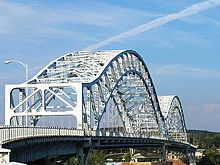Arrigoni Bridge
| Charles J. Arrigoni Bridge | |
|---|---|
 |
|
| Coordinates | 41°34′09″N 72°38′55″W / 41.56917°N 72.64861°WCoordinates: 41°34′09″N 72°38′55″W / 41.56917°N 72.64861°W |
| Carries |
|
| Crosses |
Connecticut River and |
| Locale | Middletown and Portland, Connecticut |
| Maintained by | Connecticut Department of Transportation |
| Characteristics | |
| Design | Through arch bridge |
| Total length | 3428.1 ft (1044.85 m) |
| Width | 44.9 ft (13.7 m) |
| Longest span | 2 × 660 feet (200 m) |
| Clearance below | 89 ft (27.1 m) |
| History | |
| Construction begin | 1936 |
| Construction end | 1938 |
| Opened | 1938 |
| Statistics | |
| Daily traffic | 33,600 |
The Arrigoni Bridge is a steel through arch bridge carrying Route 66 and Route 17 across the Connecticut River, connecting Middletown, Connecticut to Portland, Connecticut. When it opened in 1938, the 1,200 feet (370 m) bridge was the most expensive bridge ever built in Connecticut, at a cost of $3.5 million. Its two distinctive 600 feet (180 m) steel arches have the longest span length of any bridge in the state. The bridge has an average daily traffic of 33,600.
It was named after state legislator Charles J. Arrigoni, who promoted the project. Arrigoni served in the Connecticut House of Representatives from 1933-1936 and in the Connecticut State Senate from 1937-1940.
Portland and East Hampton, jointly known as Chatham until Portland separated in 1841, were originally part of the vast settlement of Middletown in 1652. Middletown families settled the towns east of the Connecticut River, and until the latter half of the 19th century, the only way to cross the river was via ferry. The first ferry service in Middletown began operation in 1726. The first bridge spanning the Connecticut River at Middletown was a swing truss bridge opened in 1872 carrying the New York, New Haven and Hartford Railroad. While no longer in active service, it is now known as the Providence & Worcester railroad bridge.
When the first non-railroad bridge in the area opened in 1896, it was said to be the longest highway drawbridge in the world at the time. Known as the Portland Passenger Bridge, it was built by the Berlin Iron Bridge Company for $180,000, and measured 1,300 feet (400 m) in length and had a draw span of 450 feet (140 m). It provided a roadway and an electric passenger car, accommodated foot traffic, and charged tolls for the crossing. The Portland Passenger Bridge was heavily damaged by flooding in 1936.
...
Wikipedia

